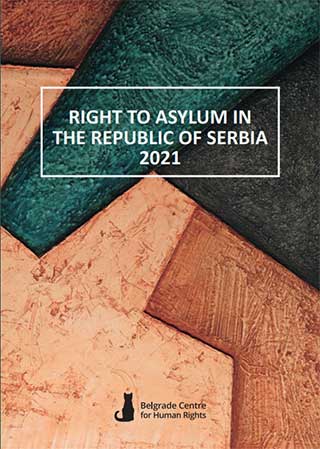The Belgrade Centre for Human Rights presented its annual report Right to Asylum in the Republic of Serbia in the Belgrade Media Center on Wednesday, 23 February 2022. The Report editor Ana Trifunović said that the data of the Serbian Commissariat for Refugees and Migration showed that over 60,000 people resided in Serbian asylum and reception centres in 2021, that 2,306 of them expressed the intention to seek asylum in Serbia and that 174 actually applied for asylum.
“Most of the people who sought asylum in Serbia were nationals of Afghanistan. The asylum authorities upheld only 14 applications in 2021, half the number of claims they approved in 2020. In 2021, the Asylum Office rejected 51 and dismissed nine applications, and discontinued reviews of 73 applications, usually because the asylum seekers decided to leave Serbia before the procedure was completed,” she said.
UNHCR Representative in Serbia Francesca Bonelli said that the number of globally displaced people in the world – 84 million – has never been higher and that 45% of them were children. She said that refugee protection was extremely important in the circumstances, with the alarming increase in the number of violent incidents against refugees and migrants and violations of their human rights at borders, not only in Europe, but elsewhere in the world as well.
“Behind that number of 84 million are displaced people, families, suffering… Walls and fences have been erected at a number of places along Europe’s borders to prevent migrants from entering the countries, while reports show that refugees are returning to their countries of origin although their lives are at risk there and they have sought international protection. This is not only in contravention of international law but of the chief principles of humanity as well,” said Bonelli.
She noted that although the vast majority of refugees perceived Serbia as a transit country, there were refugees, albeit a small number of them, who sought asylum in it, who were willing to integrate in Serbia’s society and build a new life in it.
The Right to Asylum in the Republic of Serbia 2021 report shows that the number of refugees and migrants in the territory of Serbia was stable throughout the year, ranging between five and six thousand on average. According to the December 2021 data, 60,407 people were accommodated in the centres run by the Serbian Commissariat for Refugees and Migration, a slight increase over 2020, when a total of 58,103 stayed at Serbian asylum and reception-transit centres. Although tens of thousands of asylum seekers and other migrants pass through and stay in Serbia every year, a relatively small number of them intends to seek international protection in it.
The intention to seek asylum in Serbia was expressed by 2,306 people from 1 January to 31 December 2021, a slight decrease over 2020 but a major one compared to the pre-pandemic era. Most of the foreigners who expressed the intention to seek asylum in Serbia in 2021 were nationals of Afghanistan – 1,025, followed by nationals of Syria – 466, Burundi – 134, Pakistan – 120, Bangladesh – 107, Cuba – 92, etc. A total of 174 asylum applications were filed in 2021, a slight increase over 2020, when 144 claims were submitted. Most of the applicants were Afghan nationals.
The Asylum Office upheld a total of 14 asylum applications in 2021, less than half than in 2020, when it upheld 29 claims, and much less than in 2019, when it granted refuge or subsidiary protection in 35 cases. The Asylum Office upheld the applications of 208 foreigners from 2008, when the national asylum system was established, to 31 December 2021.
Serbia in 2021 continued extending humanitarian assistance to migrants, most of whom came from refugee-generating countries. Despite some headway in the realisation of the right to asylum and access to integration-related rights, the national asylum system was still not fully functional in the reporting period; it was further stymied by the ongoing COVID-19 pandemic. A substantial number of people in need of international protection still do not perceive Serbia as a country of refuge, but merely as a country they transit on their way to EU Member States, which provide refugees with better prospects for integration and life in dignity.
Serbia still lacks sustainable systemic solutions for the adequate protection and improvement of the situation of asylum seekers, migrants and refugees, who still rely heavily on support provided by international and non-government organisations, while systemic solutions and effective coordination among the state authorities are lacking.
This 10th annual report on the right to asylum in the Republic of Serbia covering 2021 was prepared by members of BCHR’s legal and integration teams based on their experience in extending legal aid to migrants and representing asylum seekers in the asylum procedure, their field work and the support they have been extending to the integration of foreigners granted asylum in Serbia. The BCHR has been extending legal aid to asylum seekers and people granted international protection as UNHCR’s partner since 2012.
The Right to Asylum in the Republic of Serbia 2021 is available HERE.
The video of the presentation of the Report in the Belgrade Media Center is available HERE.
